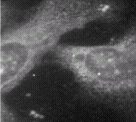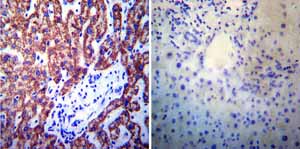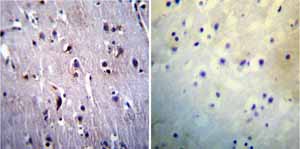Anti-Presenilin 1 antibody [APS 11]
| Name | Anti-Presenilin 1 antibody [APS 11] |
|---|---|
| Supplier | Abcam |
| Catalog | ab15456 |
| Prices | $391.00 |
| Sizes | 200 µg |
| Host | Mouse |
| Clonality | Monoclonal |
| Isotype | IgG1 |
| Clone | APS 11 |
| Applications | IP IHC-F ICC/IF ICC/IF ICC/IF WB ELISA IHC-P FC |
| Species Reactivities | Mouse, Rat, Human, Bovine, Dog, Primate, Monkey |
| Antigen | Synthetic peptide corresponding to Human Presenilin 1 aa 21-34 |
| Description | Mouse Monoclonal |
| Gene | PSEN1 |
| Conjugate | Unconjugated |
| Supplier Page | Shop |
Product images
Product References
An interactive network of elastase, secretases, and PAR-2 protein regulates CXCR1 - An interactive network of elastase, secretases, and PAR-2 protein regulates CXCR1
Bakele M, Lotz-Havla AS, Jakowetz A, Carevic M, Marcos V, Muntau AC, Gersting SW, Hartl D. J Biol Chem. 2014 Jul 25;289(30):20516-25.
Cell type-specific subcellular localization of phospho-TBK1 in response to - Cell type-specific subcellular localization of phospho-TBK1 in response to
Suzuki T, Oshiumi H, Miyashita M, Aly HH, Matsumoto M, Seya T. PLoS One. 2013 Dec 9;8(12):e83639.
Interactome mapping suggests new mechanistic details underlying Alzheimer's - Interactome mapping suggests new mechanistic details underlying Alzheimer's
Soler-Lopez M, Zanzoni A, Lluis R, Stelzl U, Aloy P. Genome Res. 2011 Mar;21(3):364-76.
HPRT deficiency coordinately dysregulates canonical Wnt and presenilin-1 - HPRT deficiency coordinately dysregulates canonical Wnt and presenilin-1
Kang TH, Guibinga GH, Jinnah HA, Friedmann T. PLoS One. 2011 Jan 28;6(1):e16572.
Analysis of oestrogen regulation of alpha-, beta- and gamma-secretase gene and - Analysis of oestrogen regulation of alpha-, beta- and gamma-secretase gene and
Nord LC, Sundqvist J, Andersson E, Fried G. Neurodegener Dis. 2010;7(6):349-64.
Simvastatin increases notch signaling activity and promotes arteriogenesis after - Simvastatin increases notch signaling activity and promotes arteriogenesis after
Zacharek A, Chen J, Cui X, Yang Y, Chopp M. Stroke. 2009 Jan;40(1):254-60.



![Overlay histogram showing HepG2 cells stained with ab15456 (red line). The cells were fixed with 80% methanol (5 min) and then permeabilized with 0.1% PBS-Tween for 20 min. The cells were then incubated in 1x PBS / 10% normal goat serum / 0.3M glycine to block non-specific protein-protein interactions followed by the antibody (ab15456, 1ug/1x106 cells) for 30 min at 22ºC. The secondary antibody used was DyLight® 488 goat anti-mouse IgG1 (H+L) (ab96879) at 1/500 dilution for 30 min at 22ºC. Isotype control antibody (black line) was Mouse IgG1 [ICIGG1] (ab91353, 2µg/1x106 cells) used under the same conditions. Acquisition of >5,000 events was performed. This antibody gave a positive signal in HepG2 cells fixed with 4% paraformaldehyde (10 min) permeabilized with 0.1% PBS-Tween for 20 min used under the same conditions.](http://www.bioprodhub.com/system/product_images/ab_products/2/sub_4/15760_Presenilin-1-Primary-antibodies-ab15456-3.jpg)